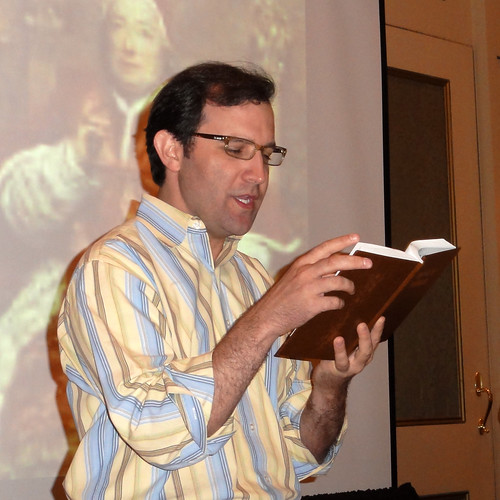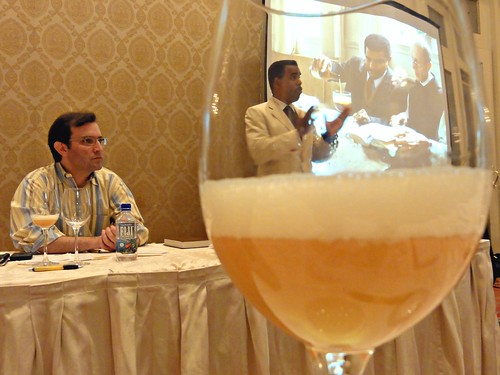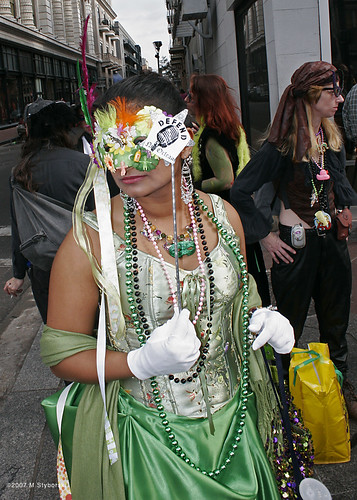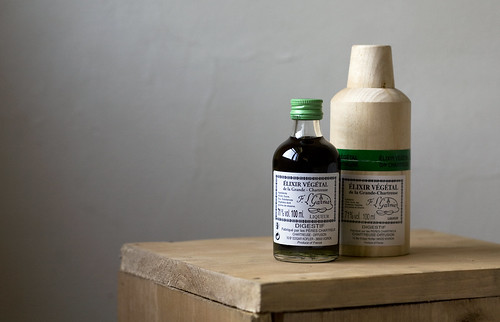How does one spend Sunday morning at Tales of the Cocktail?
How about a seminar on “Religious Spirits”?
This session was conducted by Garrett Oliver and a thankfully clean-shaven Allen Katz. Allen talked about spirits and Garrett talked about beer. I never thought I’d be drinking beer at Tales, but this session attempted to bridge the gap between distilling and brewing — in the monastic traditions.
It’s not really contradictory for monastics to make booze. We learned that beer once had a reputation as a temperate drink. Back in the olden days, people didn’t drink water much.
As Garrett put it, “Water can kill you.” In fact, water can kill the whole village. However, no known pathogens can live in beer, so beer was the safe and wholesome drink, and it didn’t have much alcohol.
Monasteries had brewed beer for a long time. When some monasteries started going “commercial” in the 1700s and 1800s, they had an edge on everyone. Their beer was the best, because of they had the science and the scholarship. Furthermore, the penalties for brewing bad beer were severe, so the competition was not fierce, and the brewing enterprise proved very worthwhile for the monasteries.
We tasted some Trappists beers. The Trappists have a reputation for being severe and silent. Many orders were driven out of France by the Revolution and ended up in Belgium. We learned the distinction between Trappist beers and Abbey beers; the former are made entirely within the walls of the monastery, while the latter are simply beers made in the same style by just about anyone, anywhere. Today, Garrett estimated, about 80% of Belgian beers are just such copies. We all know the Belgians make the best beer, and it’s pretty much because of the influence of the Trappists.
We discussed the Westvleteren Brewery, located in the Trappist Abbey of Saint Sixtus of Westvleteren. Their beer is reputed by some to be the best in the world. The monastery is extremely closed to the outside world. Garrett doesn’t know anyone who has visited them. As for the beer, it’s a rare commodity, because they brew at a very low volume. The bottles have no labels, as all legally required information is printed on the cap. In order to get some, you have to call on the “beerphone,” register your license plate, and drive there to pick it up yourself. Nice if you live in Belgium, I guess. They take these strict measures to eliminate reselling. They’re not interested in making a ton of profit, just enough to sustain the monastery and their philanthropic causes.
Beer from Rochefort Brewery may be the second rarest of the Trappist ales, in production since 1595. Alas, both Westvleteren and Rochefort were simply too difficult to obtain to be served at the seminar.
But what we had instead was nothing to sneeze at. First we tasted some Westmalle Tripel. It’s the very first Tripel, a hugely influential style. It comes from Westmalle Brewery, run by the Trappist Abbey of Westmalle. The abbey was founded 1794, and they’ve been brewing since 1836. These days they have a lot of secular workers who come in from outside to help produce the beer.
The second beer we had was from Achel Brewery, run by the Abbey of Saint Benedict. I think it was the Bruin. It was quite delicious but I preferred the Westmalle.
Allen raised the question, why do some monasteries brew beer while others distill spirits? But he said he had no clue as to what the answer might be other than the availability of ingredients.
Apparently, “innumerable” monastic orders have a tradition of distilling, but we talked about two of the most prominent, the Benedictines and Carthusians. Both are Catholic orders that were founded quite a long time ago.
The Benedictines were around for a good thousand years before they started distilling Bénédictine liqueur in 1510. The original formula was lost in French Revolution, but was “miraculously” rediscovered in early 19th century. The enterprise is now entirely secular and commercial. I think it’s now owned by Bacardi.
By way of contrast, Chartreuse is still made by the Chartreusian monks — indeed, they are the only major order where the monks still have complete control and do all the work.
As a footnote, Bénédictine is made with 27 herbs and botanicals, Chartreuse with 130.
The Chartreusian order was founded founded in middle of the 12th century, but distilling didn’t come into the picture for several hundred years. They live as a community of hermits, which I find utterly fascinating. Garrett and Allen described a visit to a monastery like peeling back layers of an onion. They both talked about hanging out with monks. Monks had lives before they took their vows, and apparently they are even capable of remembering that time before they cloistered themselves away from the world.
Given that we’re in New Orleans, no account of Chartreuse would be complete without a nod to the Krewe of Chartreuse, a Carnival walking club that’s been around for many a year. I’ve never participated in their festive Chartreuse-fueled rites, but I’ve certainly been aware of them for a good long time. Indeed, I was introduced to my first taste of Chartreuse by founding Krewe member Loki, Minister of Volume, back in the day. And here’s the incomparable Maitri at Mardi Gras 2007.
That photo was taken by fellow traveler M Styborski, someone I knew mainly through social network sites until this year’s Tales of the Cocktail, when by sheer happenstance he landed in the seat next to me.
As you can see, he’s a photographer. Check out his photostream. And his presence was far from a coincidence. Indeed, he was there to cover the event for Humid City, the NOLA über-blog founded by none other than the Minister of Volume himself.
So you see we’ve come full circle.
Yes, we had some cocktails, the Last Word featuring Chartreuse and the Vieux Carré featuring Bénédictine. This last has the added allure of being invented at the Monteleone, and of course the Monteleone is ground zero for Tales of the Cocktail.
So you see we’ve come full circle. Just like the Carousel Bar. Which is at the Monteleone. Help, I’m trapped in an Eternal Return!
But seriously, I want to give props to Allen and Garrett for a seminar that seemed to represent the highest level of scholarship and intellectual depth of any of the seminars I attended this year.
Post scriptum: Allen offered a giveaway of a bottle of Élixir Végétal de la Grande-Chartreuse. This stuff is impossible to get in the United States and is said to be the ancestor of the Chartreuse liqueur. (Though that may be nothing but a “wonderful fantasy.”) In any event it seems this was an early effort by the Chartreusians to make a healthful medicine. And thus I have to post this classy photo by Brother O’Mara which caught my eye not so long ago.
So you see we’ve come full circle.
Discover more from b.rox
Subscribe to get the latest posts sent to your email.






Hey, if you ever want a bottle of that Elixir Vegetal just let me know. I can get you some as early as October.
Or, you know, you can just come over and taste mine any time and see if you actually want some.
The Last Word is my favorite cocktail ever. Dear lord of religious cocktails, is it ever mmm mmm tasty. Alas, no Maitri story is without irony. Maraschino liqueur is banned in the state of Ohio. BANNED. Can you believe that? I will have to rectify this situation by buying some in New Orleans during my next visit.